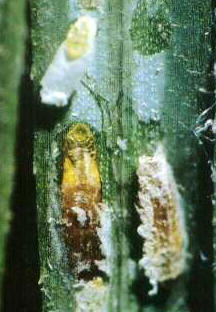Elongate Hemlock Scale
 DESCRIPTION & LIFE CYCLE
DESCRIPTION & LIFE CYCLE
The Elongate Hemlock Scale is a serious armored scale pest of the Hemlock. These Scales also infest Fir, Spruce and Yews, but these plants tend to be only secondary hosts. Such secondary hosts, if infested, are usually found adjacent to infested Hemlocks.
Elongate Hemlock Scale overwinter as adult females. In early Spring the females deposit eggs beneath their waxy scale covers and may continue to do so through early Summer. In 3-4 weeks, eggs hatch into nymphs (crawlers) which migrate to new needles on the same plant. Crawlers settle on the underside of the needle, insert their mouthparts and feed for 3-4 weeks and molt into a sedentary stage. Another 4 weeks is required to complete maturity. The scale of the adult female is easily recognized by a flattened, elongated covering which is brownish-orange and about 1.5 mm in length. The scale covering the male is slightly smaller and white. At maturity, the male emerges as a tiny winged insect, mates with the female and dies. The mated female starts to lay second generation eggs 6-8 weeks after mating. Scales from these eggs mature and overwinter.
MONITORING & DETECTION
Look for Hemlocks with a yellowish cast, particularly in the lower branches, that may resemble Spider Mite damage. Look on the underside of needles for tan to brown female covers and white male covers.
DAMAGE
Scales injure host plants by inserting their threadlike mouthparts into the needle and withdrawing vital nutrients necessary for plant growth. Excessive loss of plant sap reduces the growth and vigor of the plant, and causes needles to turn yellow and drop prematurely. In light infestations, some needles have yellow spots; in moderate infestations, many needles become yellowish; and in heavy infestations, needle drop occurs and trees are killed. The underside of needles may appear whitish from the white, waxy threads and covers produced by the males.
CONTROL
Formulations of horticultural spray oil, imidacloprid (Merit), and insecticidal soap are labeled for Elongate Hemlock Scale control.* Crawlers can be controlled from mid-May to mid-June. Egg laying and crawler activity occur throughout the growing season. Several spray applications may be required if an infestation is severe. Follow all label directions for specific information on host plant label clearance, phytotoxicity information, safety precautions and dosage information.
* See Woody Ornamental Insect, Mite and Disease Management, The Pennsylvania State University (2005) for more details.
WARNING: Pesticides are poisonous. Read and follow directions and safety precautions on labels. Handle carefully and store in original labeled containers out of reach of children, pets and livestock. Dispose of empty containers right away , in a safe manner and place. Do not contaminate forage, streams or ponds.
For professional assistance with tree and shrub problems contact a Keystone arborist
Penn State Fact Sheet on Elongate Hemlock Scale


